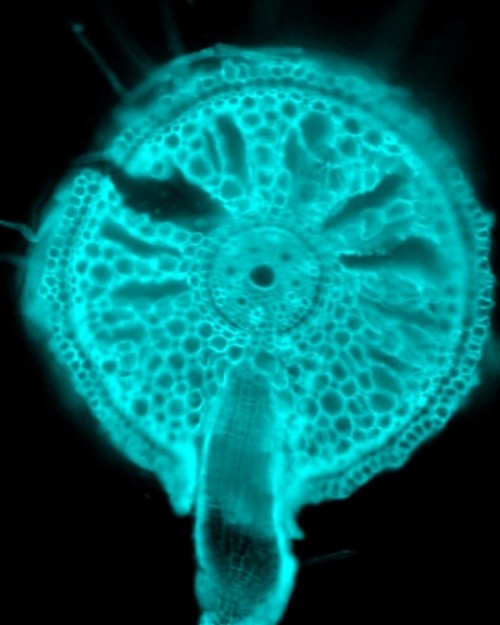PNAS:植物根利用图式发育机制决定外侧根分支方向
土壤是一种隐秘的微观迷宫,其裂缝中承载着广泛的生命。植物通过发育一种复杂的根系分支网络接近稀缺资源如水和营养素来探索这个环境。根系如何感知哪个土壤区域含有水,以及这个水分怎样影响根系统的体系结构到现在仍然不清楚。

由Carnegie's José Dinneny领导的团队最新研究重点根的局部环境的物理性质如何控制根分枝并通过哪种发育途径这些信号活动。他们的研究成果发表在《PNAS》期刊上,描述了一种异常过程称为hydropatterning,允许植物优化根分枝以吸水。
植物根在土地上形成一种类似的分支网络,用外侧根从主轴生长出来。因为水在土壤中不是均匀分布的,根系统网络的结构需要用优化土壤探测途径来调节,同时限制生长到水分贫瘠的区域。
Dinneny 与他的团队开发一种在根周围水和空气的分布高度控制的环境中生长根系的方法。通过分析新分枝形成的位置,研究人员发现植物倾向于放置这些根分枝到极为贴近有水存在的地方,而微小的根毛出现在易接触到空气的区域。
他们的工作显示相同的单根对侧是空气或水源获得的最佳位置当环境多变时。与诺丁汉大学同事Malcolm Bennett 和Sacha Mooney 合作,微x射线断层扫描用于建立土壤中根生长的3D模型,显示出在这些自然环境中发生的相似过程。
“我们完全低估了根图式发育系统的空间视敏度。它吸引人发现根能对小于100微米会上的环境条件改变有反应,这是标准土壤颗粒的大小,”Dinneny说。
该团队命名这种新现象为hydropatterning,并在几个植物物种中观察它,包括重要的农作物植物玉米和水稻。该过程在以前干旱应答植物中通过信号通路控制,暗示hydropatterning对于在非应激生长条件下调节根分枝是重要的。
“这一简单观测为我们的调查开辟了一个全新领域,”Dinneny说。“植物细胞区别潮湿与干燥环境是重要的,可能会导致更好了解植物如何有效利用水。”
原文摘要:
Plant roots use a patterning mechanism to position lateral root branches toward available water
Yun Bao,Pooja Aggarwal,Neil E. Robbins II,Craig J. Sturrock,Mark C. Thompson,Han Qi Tan,Cliff Tham,Lina Duan,Pedro L. Rodriguez,Teva Vernoux,Sacha J. Mooney,Malcolm J. Bennett and José R. Dinneny
The architecture of the branched root system of plants is a major determinant of vigor. Water availability is known to impact root physiology and growth; however, the spatial scale at which this stimulus influences root architecture is poorly understood. Here we reveal that differences in the availability of water across the circumferential axis of the root create spatial cues that determine the position of lateral root branches. We show that roots of several plant species can distinguish between a wet surface and air environments and that this also impacts the patterning of root hairs, anthocyanins, and aerenchyma in a phenomenon we describe as hydropatterning. This environmental response is distinct from a touch response and requires available water to induce lateral roots along a contacted surface. X-ray microscale computed tomography and 3D reconstruction of soil-grown root systems demonstrate that such responses also occur under physiologically relevant conditions. Using early-stage lateral root markers, we show that hydropatterning acts before the initiation stage and likely determines the circumferential position at which lateral root founder cells are specified. Hydropatterning is independent of endogenous abscisic acid signaling, distinguishing it from a classic water-stress response. Higher water availability induces the biosynthesis and transport of the lateral root-inductive signal auxin through local regulation of TRYPTOPHAN AMINOTRANSFERASE OF ARABIDOPSIS 1 and PIN-FORMED 3, both of which are necessary for normal hydropatterning. Our work suggests that water availability is sensed and interpreted at the suborgan level and locally patterns a wide variety of developmental processes in the root.
作者:Snail

